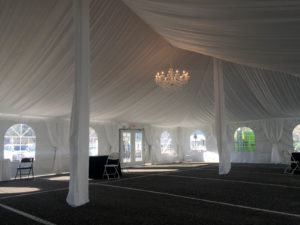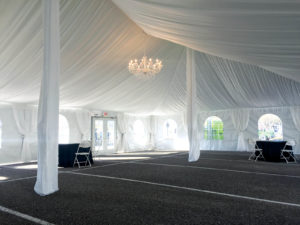
Only have a smartphone? That’ll work fine.
An estimated 1.2 trillion photos were taken around the globe in 2017. The smartphone, of course, is what’s behind the huge number. According to InfoTrends, a market research firm, 85 percent of all photos are shot with a phone.
A good smartphone gives you a simple way to capture your company’s work. The catch, though, is that despite the improvement in smartphone cameras, a lot of photos taken with them just aren’t very good. Most of the time that’s fine; what you post on social media is meant to capture a moment, not establish you as a modern-day Ansel Adams.
However, there are times when you want a quality photograph to really showcase a tent installation. This magazine is a good example. Photos are a critical part of its editorial presentation, and it relies on event professionals to supply photos to illustrate articles and grace the cover.
The goal of this article is to help you take better photos. It will also include tips about what to do with those photos to make them suitable for publication—whether it’s in this magazine, in your own marketing materials or elsewhere.
I’m a published photographer who has exhibited work across the Midwest, and part of my job is to keep up with the latest and greatest techniques for shooting photos. This column is an opportunity to share some of my knowledge, but I’ve also consulted a veteran of the photography business, Dan Grevas, who has owned and operated Dan Grevas Photography in South St. Paul, Minn., for almost three decades. We put our heads together to come up with these suggestions.
 Tools of the trade
Tools of the trade
While smartphones are the ultimate in point-and-shoot, if you’ve been using a real digital camera—a digital single lens reflex (DSLR), a compact or something in between—and are comfortable and confident with it, by all means continue. Smartphone cameras have improved by leaps and bounds in recent years, but a stand-alone camera is still capable of taking the best photos. Such cameras do require a bit more skill than using a smartphone, so go for a smartphone if that’s easiest for you.
Any decent smartphone manufactured in the last few years should be adequate for most photographic purposes. What this publication needs, for example, are high-resolution photos: a file at least 1 megabyte (MB) in size for use inside the magazine, and about 6 MB for a cover shot. We’re not going to get too technical here, but the size of your photo is determined in large part by the megapixels that can be captured by your camera’s sensor (the more megapixels, the better). Current top-of-the-line smartphones such as the Apple iPhone® 8 and X models have a 12 MP camera that can produce files large enough for most uses.
One reason professional photos look professional is that they’ve gone through an extensive editing process. It’s true that editing software such as Adobe Photoshop® can bring out the best in a photo, but it requires dedication to master the art of photo editing, and that takes time that is probably better spent on other areas of your business. Your goal should be to get good shots right out of the camera. The question is: How do you do that?
Simple preparations
Before you shoot, make sure your phone is set to save the photos at the largest size possible; some smartphones will reduce the size if you’re running low on storage space.
Use a soft cloth or a shirt to wipe off your lens. Most cell phone lenses have oil and dirt and dust all over them, and when you’re working with a phone, every little bit helps.
When you’re ready to shoot, pay attention—close attention—to what you see on the screen of your camera or smartphone. Don’t just point and shoot. Get the whole scene that you want to highlight in the frame, and show it from a pleasing angle. The best angle is often not straight from the side or front.
Eliminate unwanted elements before you shoot. When you are taking a photo of a finished installation, ensure there are no tools, equipment or unused inventory in the shot. Don’t depend on cropping those items out later because that reduces the amount of digital “information” you have to work with.
In many cases, the presence of a human being can add immeasurably to the appeal of a photo. When you’re shooting a tent installation, if possible take at least some photos showing you or a member of your crew doing some of the work (not staring at the camera). If you are taking shots of an installation in progress, make sure all of your crew members are wearing their personal protective equipment (PPE)!
It’s all about light
Photography is all about light, and therein lies the challenge. Even the best cameras can have problems getting the correct exposure, especially when you are shooting a tent installation. During the day, when light comes through the sides of a tent (in the case of a tent with no sidewalls or clear sidewalls or windows), your camera or smartphone will probably, by default, take an exposure reading that averages out the brightness in the frame. This, theoretically if not always in practice, will avoid “blowing out” the light areas (so that they aren’t all white), but in turn will often make much of what’s under the tent too dark.
To avoid that issue, if you’re using a DSLR, you can set the camera to use spot metering, which sets the exposure not on an average but from a specific spot where you are focusing. You can also use the center-weight metering setting, which does not measure where you are focused but instead makes sure the center of the frame is exposed correctly.
The best thing about digital photography is that you can see your results immediately, on the back of the camera. When lighting conditions are tricky, it may be necessary to try a number of meter settings until you find one that works. Experienced photographers will also learn to use exposure compensation settings on their camera to fine-tune the results even more.
If you’re using a smartphone, your exposure choices are more limited, but it’s also easy to immediately see whether your photo is going to be properly exposed. Smartphone cameras will generally show you your focus point (an illuminated box), which you can change by tapping on the screen. If your focus point leaves critical parts of the photo too dark, try tapping in different places to change the lighting so it’s better. Your phone camera should allow enough depth of field to keep the important stuff in focus even if the main focus point is elsewhere.
Finally, a lack of adequate light may make it hard to hold the camera still long enough to get a photo that isn’t blurry. If you’re using a DSLR, a tripod may help. If you’re using a smartphone, try setting it on a table or something similar to help prevent movement; there are also mini-tripods available specially made for smartphones.
After you shoot
Once you’ve shot good photos, you’re not off the hook quite yet. Getting the photos from your phone to their final destination can be a challenge as well.
A problem is that photo files sometimes get compressed when saved to a computer or an online photo storage site or when they are emailed. It’s impossible to give comprehensive instructions for how to avoid photo compression, because every phone and computer and online storage site does things in a different way. But, for example, if you have an iPhone, be sure when emailing a photo to select the “actual size” to send, not any of the small, medium or large choices.
If you find you’re having difficulty emailing high-resolution photos, consider using a file storage site such as Dropbox™. You can upload your photos at their highest resolution and then give access to collaborators so they can download them to their own computer.
This column has just scratched the surface, but hopefully these tips will help your photography, whether your pictures end up on Facebook or in the pages of this magazine.
Jeff Moravec is a photographer and freelance writer based in Minneapolis, Minn.
Many photographers find it easiest to shoot horizontal (or “landscape”) photos, if for no other reason than it’s the default position with a DSLR. A smartphone, on the other hand, needs to be turned sideways to shoot a horizontal photo. The increasing popularity of the social media photo site Instagram, which features mostly vertical (or “portrait”) shots, has changed the mix a bit, but horizontal is still more common. Magazines such as this one need both horizontal and vertical photos, depending on page layouts, but the cover photo is always vertical, so if you plan on submitting photos, shooting a mix of both styles is recommended. A horizontal photo can sometimes be cropped to a vertical format, but it can be difficult.
 TEXTILES.ORG
TEXTILES.ORG


